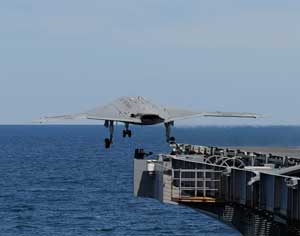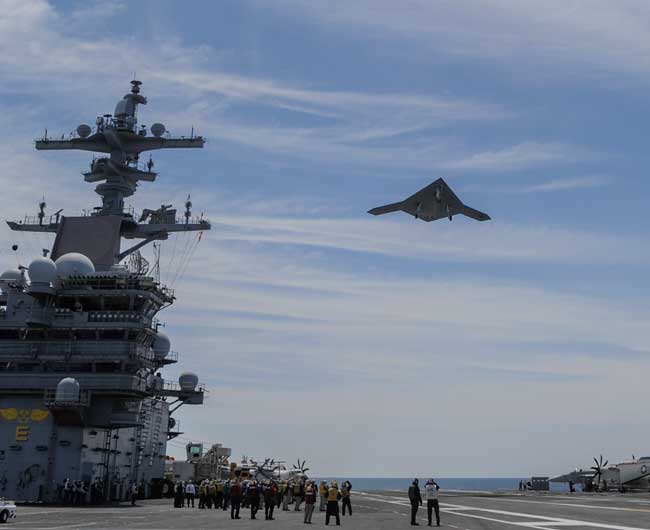

The X-47B Unmanned Combat Air System demonstrator (UCAS-D) completed its first ever carrier-based catapult launch from USS George H.W. Bush (CVN 77) off the coast of Virginia May 14, 2013.
“Today we saw a small, but significant pixel in the future picture of our Navy as we begin integration of unmanned systems into arguably the most complex warfighting environment that exists today: the flight deck of a nuclear-powered aircraft carrier,” said Vice Adm. David Buss, commander, Naval Air Forces, the Navy’s “Air Boss”.
The unmanned aircraft launched from the deck of George H.W. Bush at 11:18 a.m. It executed several planned low approaches to the carrier and safely transited across the Chesapeake Bay to land at Naval Air Station Patuxent River, Md., after a 65-minute flight.
Buss called the launch a “watershed event” in naval aviation and said he expects that decades from now, a future “Air Boss” will have a picture of the X-47B launching from Bush behind his or her desk just as he has a picture of aviation pioneer Eugene Ely’s first-ever landing on the deck of a ship in 1911 behind his desk today.
“This ship and her crew continuously meet the challenges placed before them,” said the ship’s commanding officer, Capt. Brian E. Luther. “The successful launch of the X-47B is yet another first on USS George H.W. Bush. We were excited to host the experimental aircraft, and are proud to know we have played a part in a significant milestone in naval aviation.”
Completing another important first for the UCAS-D program, the team demonstrated the ability to precisely navigate the X-47B within the controlled airspace around an aircraft carrier at sea and seamlessly pass control of the air vehicle from a “mission operator” aboard the carrier to one located in the Mission Test Control Center at NAS Patuxent River for landing.
“The flight today demonstrated that the X-47B is capable of operation from a carrier, hand-off from one mission control station to another, flight through the national airspace, and recovery at another location without degradation in safety or precision,” said Matt Funk, lead test engineer for the Navy UCAS program.
Prior to the catapult launch on Tuesday, the UCAS test team also conducted deck-handling and ship-integration testing to demonstrate the capability to safely operate the X-47B in the dynamic, unforgiving environment of an aircraft carrier flight deck.
“This event is a testament to the teamwork, professionalism and expertise of everyone involved with X-47B program,” said Rear Adm. Mat Winter, program executive officer for Unmanned Aviation and Strike Weapons. “Their work will positively impact future unmanned aviation development for years to come.”
Over the next few weeks, the X-47B aircraft will fly approaches to the ship multiple times and eventually land on the pitching flight deck, said Navy UCAS Program Manager Capt. Jaime Engdahl.
The UCAS team will conduct additional shore-based testing with the X-47B at NAS Patuxent River in the coming months before its final carrier-based arrested landing demonstration later this summer.
3 days later – Touch and Go
Three days after leaving the aircraft carrier USS George H. W. Bush on the first catapult launch, the Northrop Grumman X-47B Unmanned Combat Air System Demonstrator (UCAS-D) returned to the carrier for a ‘touch and go’ landing trial, successfully testing the automatic landing system which integrates reference signals from the carrier deck and the drone’s avionics, conducting fully automatic approach and precision touchdown landing. On this landing test the drone touched down within the locations that would enable the tailhook to catch the arresting cables and slow the aircraft to a complete stop within the required parameters. After the test landing the aircraft returned to its shore-base at Patuxent River Naval Air Station in Maryland. The aircraft is expected to conduct shore based arrested landings at Pax River in the coming months, before final carrier-based arrestments scheduled for later in 2013.
Capt. Jamie Engdahl, Program Manager for UAS program office at the U.S. Navy the X-47B will continue to demonstrate consistent, reliable and repeatable touch down on a moving carrier flight deck, “this precision relative navigation technology is key to ensuring future unmanned systems can operate off our aircraft carriers”.



















